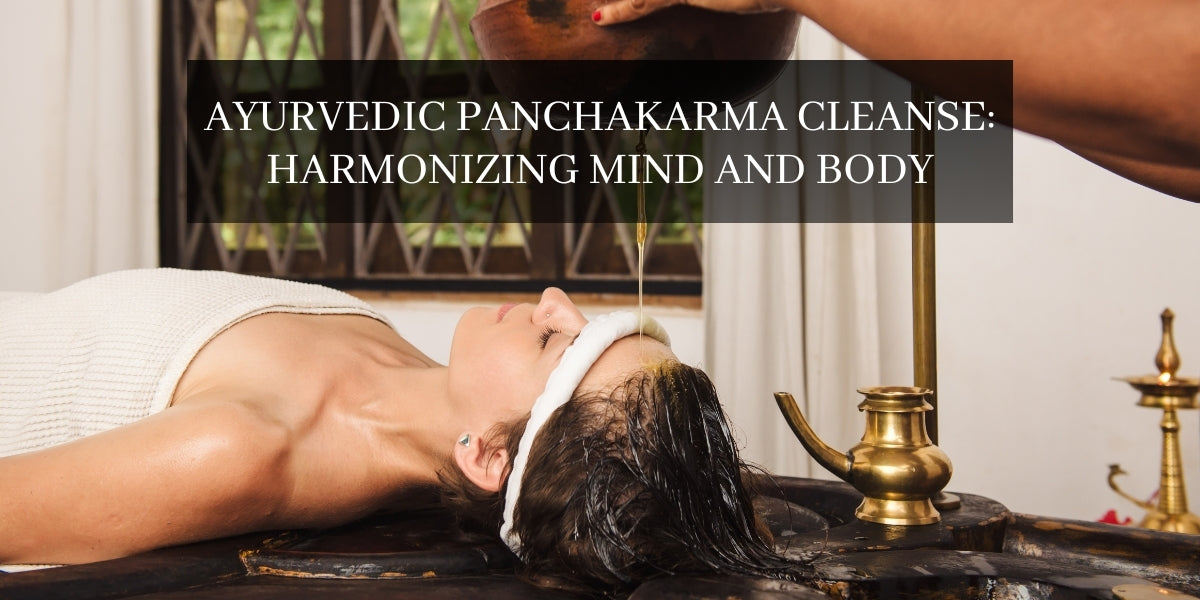Cart
You have no items in your shopping cart.

Are you looking for a natural way to rejuvenate and find inner peace? Are you curious about how to detoxify your body? Look no further than Ayurvedic Panchakarma, a detoxification method. Think of a journey that gently cleanses your body and mind, eliminates toxins, and restores balance. Panchakarma, with its five transforming components/karma, provides a comprehensive approach to well-being. This Ayurvedic-based traditional practice contains the key to unleashing the potential of your body's intrinsic healing capacities.
Panchakarma focuses on the idea that everything in the cosmos is composed of the five basic elements of nature: ether, air, fire, water, and earth.
Panchakarma literally translates to "five actions" or "five treatments" in Sanskrit. It is an amazing cleansing procedure that removes toxins from the body and restores the body's natural healing capacities. It is a thorough system of purifying methods used to rid the body of all undesired waste and to bring the body, mind, and soul back into harmony.
In this article, let's go through what Panchakarma is and how it aids in body purification.
According to Ayurveda, health does not imply the absence of disease. Rather, it is the normal state of the three doshas - vata, pitta, and kapha - which represent the neurological system, metabolic system, and nutritive system. These doshas balance the human body, mind, and emotions. When the intricate equilibrium between these doshas is disturbed, the disease develops.
Ayurvedic Panchakarma is a complete system of Ayurvedic cleaning and detoxification therapy. Panchakarma refers to the five basic therapeutic treatment options that are designed to eliminate toxins and restore physical balance. These five methods are Vamana, Virechana, Vasti (Sneha Vasti & Kashaya Vasti), Nasya, and Raktamokshana. Panchakarma has numerous benefits because it enables the biological system to rapidly restore balance, regenerate, and promote the desired pharmacological and therapeutic effects of medications administered later.
A Panchakarma cleanse aims not only to remove physical impurities but also to return the mind-body system to a healthy state of balance on all levels.
Some benefits of Ayurvedic Panchakarma are:
The entire Panchakarma procedure consists of three steps:
This is an initial treatment that softens the tissues so that the lipid-soluble toxins deposited in them are dissolved, flow back into the body’s main channels, and can be eliminated from there. This treatment psychologically and physically prepares the patient for the main Panchakarma operation.
It entails the following steps.
Following the completion of Snehana, Swedana, and Shirodhara, Ama enters the GI tract and can be eliminated using the primary Panchakarma therapies: Vamana, Nasya, Virechan, Raktamokshana, and Vasti. Each of these therapies stimulates the clearance of Ama via natural elimination pathways, either upward, downward, or through the periphery (skin).
The processes that follow the major therapies of Panchakarma, known as Paschatkarma, are designed to help the body re-establish a healthy metabolic system and immune system. If these post-Panchakarma cleaning methods are not followed, digestion may not restore to normal, and Ama formation will keep happening. Ayurveda suggests a gradual return to regular activities as well as a customized diet, herbal formulations, and lifestyle changes.
During this phase, Rasayanas, or herbal remedies having unique rejuvenating effects on the body and mind, may be advised. Rasayanas boost vitality and energy, nourish and renew the entire body, and are thus an integral part of the Paschatkarma processes.
Diet is also important, both during and after the program. Because heavy food disrupts the cleaning process, it is best to eat modest portions of khichadi or kitchari. Khichadi is a detoxifying and healthy dish made from mung beans, basmati rice, spices, and clarified butter (ghee). It gives the body enough fuel to keep it strong and keeps the digestive fire burning throughout the procedure.
1. What happens to your body after Panchakarma?
Panchakarma promotes health and the body's ability to cure itself. It promotes the functioning of all organs and aids in the attainment of good mental health.
2. How to detox your body according to Ayurveda?
Ayurvedic detoxification consists of five techniques that help remove toxins from the body and restore equilibrium among all three doshas.
Panchakarma is unique as it is customized to your specific needs. A trained Ayurvedic clinician must examine the imbalances in your body, your body constitution, the current state of Doshas, and the involvement of cells, pathways, and organs before performing Panchakarma.
Panchakarma programs may take merely a week or as long as a month or more. During this period, the client is encouraged to reduce stress, set aside as many typical worries as possible, and embrace a more Sattvic lifestyle. It is beneficial to the healing process to surround oneself with a pleasant atmosphere, reduce sensory input, and avoid coming across experiences that provoke intense emotions. Meditation, yoga, and breathing exercises are also recommended. Environmental regulation and daily practices support the detoxification mechanism.




Ayurveda’s timeless principles have always intrigued us, and exploring the Panchakarma Cleanse has been an enlightening journey. The prospect of nurturing a balanced synergy between the mental and physical facets of well-being is an aspiration that resonates profoundly. This blog post delves into the core tenets of Panchakarma, explaining how it facilitates detoxification, rejuvenation, and ultimately, a holistic sense of equilibrium.